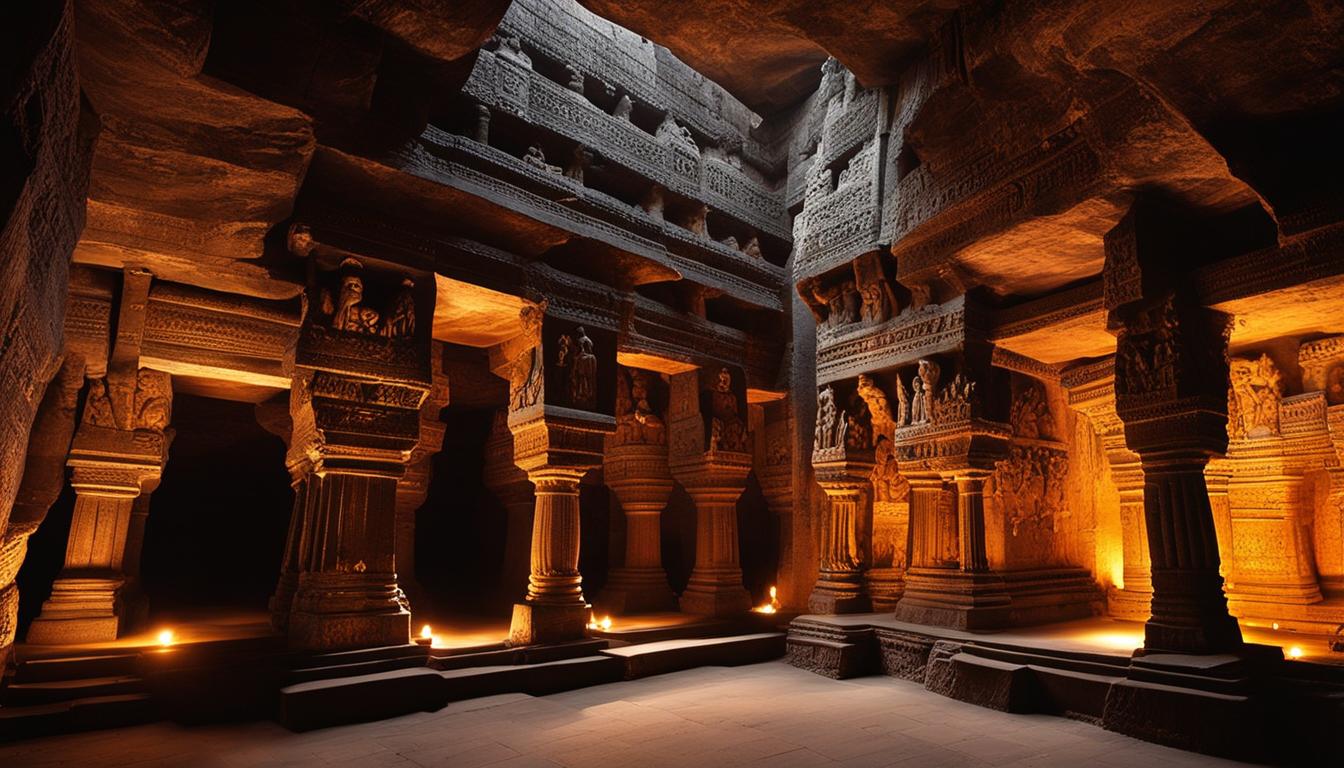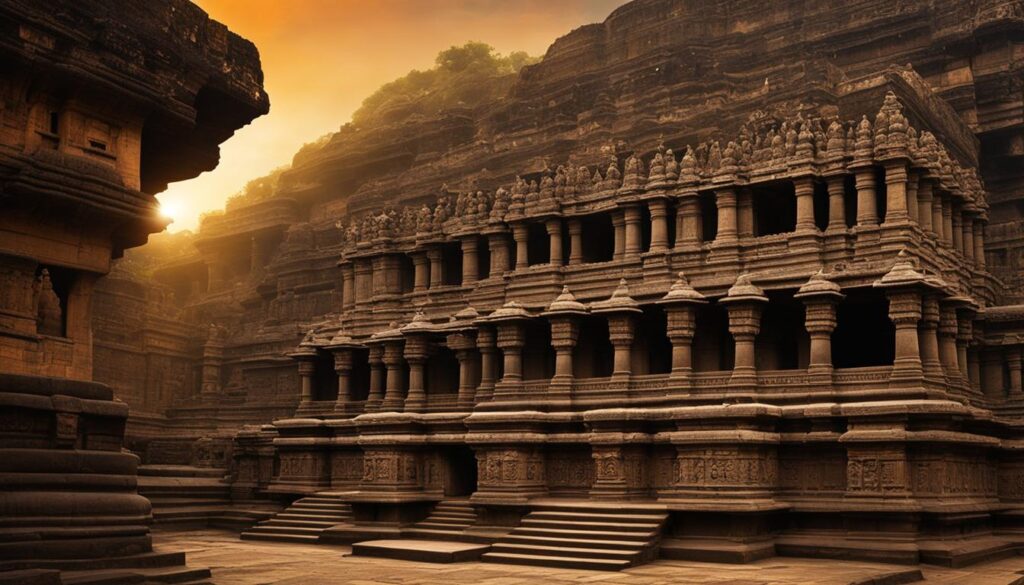
Exploring India’s Ajanta Ellora Caves Mystique
Have you ever dreamt of stepping back in time and immersing yourself in the fascinating history and artistry of ancient India? A place where age-old secrets and architectural wonders await at every turn? Look no further than the mesmerizing Ajanta and Ellora Caves in India, a true testament to the country’s rich cultural heritage.
Imagine standing in awe before the ancient rock-cut caves, feeling a sense of wonder and reverence for the civilizations that once thrived within their walls. These caves, designated as a UNESCO World Heritage Site, are not mere structures, but windows into a bygone era where Buddhist and Hindu architecture flourished in harmony.
As you enter the Ajanta Caves, dating back to the 2nd century BCE to the 5th century CE, you can almost hear the whispers of the ancient monks who once inhabited these sacred spaces. The walls adorned with intricately carved sculptures and vibrant murals depict tales of spiritual enlightenment and devotion, transporting you to a profound spiritual realm.
And then, a visit to the Ellora Caves reveals a fusion of Hindu, Buddhist, and Jain art and architecture. These majestic cave temples, created over centuries, invite you to marvel at the skill and ingenuity of the craftsmen who carved each intricate detail.
The Ajanta and Ellora Caves are not just architectural marvels; they are living symbols of India’s glorious past. They will leave you spellbound, providing a profound sense of connection to the ancient civilizations that carved their legacies within these hallowed walls.
Key Takeaways:
- The Ajanta and Ellora Caves are ancient rock-cut caves in India, designated as a UNESCO World Heritage Site.
- The Ajanta Caves primarily showcase Buddhist art and played a crucial role in the development of Buddhism in India.
- The Ellora Caves feature a harmonious coexistence of Hindu, Buddhist, and Jain art and architecture.
- These caves hold immense historical and cultural significance, making them a must-visit destination for anyone interested in India’s rich heritage.
- Experience the mystical allure and delve into the fascinating history and artistry of India through a visit to the Ajanta and Ellora Caves.
Historical Significance of the Ajanta and Ellora Caves
The Ajanta and Ellora Caves hold deep historical significance, with their origins tracing back thousands of years. The Ajanta Caves, constructed during the Satavahana dynasty from the 2nd century BCE to the 5th century CE, are a testament to the talent and creativity of ancient Indian craftsmen. These cave temples were meticulously excavated from the mountainside, showcasing magnificent rock-cut architecture.
On the other hand, the Ellora Caves spanned five centuries, from the 5th century CE to the 10th century CE, and witnessed the rule of various dynasties. The caves provide a glimpse into the rich history of ancient India, reflecting the cultural and religious life of the time. They feature beautifully carved sculptures and intricate reliefs that depict the artistic and architectural evolution of different periods.
The Ajanta and Ellora Caves are not just architectural masterpieces; they also serve as vital historical monuments and significant archaeological sites. These caves offer valuable insights into the religious practices, social life, and artistic traditions of ancient India. They provide an immersive experience, transporting visitors back in time to explore the cultural tapestry of the region’s past.
The Ajanta and Ellora Caves stand as remarkable testaments to the creativity and craftsmanship of the people who constructed them. Each cave tells a story, preserving the legacy of the past and offering a connection to our cultural heritage. As visitors explore these magnificent cave temples, they are greeted by awe-inspiring sculptures, serene Buddha statues, and intricately carved pillars. The historical significance of the Ajanta and Ellora Caves is unparalleled, making them a must-visit destination for history enthusiasts, archaeology aficionados, and admirers of ancient art and culture.
The Archaeological Significance
The Ajanta and Ellora Caves are more than just architectural wonders; they hold immense importance from an archaeological perspective. These cave complexes offer a wealth of information about the religious beliefs, social structures, and artistic techniques of ancient Indian civilizations. Each cave tells a unique story, capturing the essence of a bygone era and helping us piece together the puzzle of India’s rich historical past. The meticulous carvings and intricate details found within these caves provide valuable insights into the artistic and cultural practices of the time.
Moreover, the preservation of these cave temples is vital in maintaining their historical value and ensuring future generations can continue to appreciate and learn from them. Archaeological excavations and ongoing research at the Ajanta and Ellora Caves contribute to the understanding of India’s ancient history and shed light on the architectural prowess and spiritual devotion of the societies that thrived in the region centuries ago.
| Historical Significance of the Ajanta and Ellora Caves | |
|---|---|
| Origin | Ajanta: 2nd century BCE to 5th century CE Ellora: 5th century CE to 10th century CE |
| Builders | Satavahana dynasty for Ajanta Various dynasties for Ellora |
| Architecture | Ajanta: Primarily rock-cut Buddhist cave temples Ellora: Combination of Hindu, Buddhist, and Jain cave temples |
| Historical Significance | Ajanta and Ellora Caves serve as important historical monuments and archaeological sites that provide insights into the religious and cultural life of ancient India. |
Religious and Cultural Significance of the Ajanta and Ellora Caves
The Ajanta and Ellora Caves hold immense religious and cultural significance. These ancient rock-cut caves showcase a magnificent blend of Hindu, Buddhist, and Jain art and architecture, exemplifying the religious tolerance and inclusiveness of ancient Indian society.
“The Ellora Caves are a true testament to the diverse religious beliefs that coexisted harmoniously in ancient India. The rock-cut temples dedicated to Hindu, Buddhist, and Jain deities beautifully showcase the rich heritage of these religions.” – Archaeologist, Dr. Ravi Gupta
The Ajanta Caves, predominantly Buddhist in nature, had a profound impact on the development and propagation of Buddhism in India. The elaborate murals and exquisite sculptures within the caves depict various episodes from the Buddha’s life, offering spiritual and historical insights.
Notably, the Ajanta and Ellora Caves are not only pilgrimage sites for followers of different faiths but also attract tourists from around the world. The captivating beauty and historical significance of these caves make them an integral part of Maharashtra tourism and a fascinating Indian heritage site.

The Cultural Synthesis of the Ellora Caves
The Ellora Caves, spanning a period of five centuries from the 5th to the 10th century CE, showcase the remarkable synthesis of artistic styles and religious influences. Hindu, Buddhist, and Jain deities are depicted side by side, reflecting the interconnectedness and interdependence of these ancient religious traditions.
“The Ellora Caves present a rare glimpse into the cultural melting pot that was ancient India. The intricate carvings and sculptures illustrate the shared narratives and iconography across different religions, highlighting a message of unity and coexistence.” – Historian, Dr. Meera Sharma
The Ellora Caves not only serve as a visual feast for art enthusiasts but also provide valuable insights into the religious, cultural, and social fabric of ancient India. Exploring these remarkable cave temples is an enriching experience that deepens our understanding of India’s vibrant past.
Conclusion
The Ajanta and Ellora Caves in India are not just architectural gems, but also a testament to the rich cultural and religious heritage of the country. These UNESCO World Heritage Sites are famous for their ancient rock-cut architecture, which showcases the artistic and engineering prowess of the artisans who created them. Exploring these caves offers a unique opportunity to delve into the religious and artistic traditions of ancient times.
Whether you are a history enthusiast, a spiritual seeker, or a curious traveler, a visit to the Ajanta and Ellora Caves should be on your bucket list. The caves provide a mesmerizing experience, where you can witness the intricate details of the sculpture, the play of light and shadow, and the serene atmosphere that transports you to a bygone era.
When you visit these Indian heritage sites, you not only witness the architectural marvels, but you also contribute to the preservation of the caves and the promotion of Maharashtra tourism. The Ajanta and Ellora Caves are a source of pride for the people of India and serve as a reminder of the rich cultural diversity that defines the country.
So, plan your journey to Maharashtra and embark on a captivating exploration of the Ajanta and Ellora Caves, where history, art, and spirituality converge to create an unforgettable experience.
Source Links
- https://indianculture.com/the-mystical-caves-of-ellora-and-ajanta/
- https://www.thegrandindianroute.com/the-mystical-world-of-ajanta-caves-a-guide/
- https://www.easemytrip.com/travel/explore-mystical-caves-of-india-to-understand-their-religious-connection.html

Leave a Reply